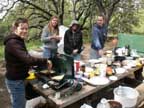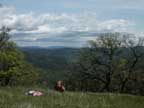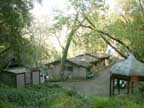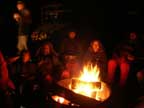Astro 28F: Field Astronomy at Henry Coe State Park
Post-Trip Highlights
After setting up camp we rendezvouzed near Chesboro Resevoir for the graze
on the 6% waxing moon. One contingent of students helped TA Dave McKulle set
up an 8" scope and got over 10 timings by voice/recorder techniques. Another
group accompanied Astro clubber's Bob Cisowski and Tom Trumbull who nailed the
northern, deeper chord on the moon with 4 timings.
 Most
students stayed with our leader - that'd be me - who used the videocamera and
TV/VCR to get 12 events from the central station. Here, I am pointing out the
star against the earthlit moon and ghostly sunlit peaks on the dark side of
the moon. Adrian is apparently appealing to the graze gods to keep the clouds
at bay, successfully at that!
Most
students stayed with our leader - that'd be me - who used the videocamera and
TV/VCR to get 12 events from the central station. Here, I am pointing out the
star against the earthlit moon and ghostly sunlit peaks on the dark side of
the moon. Adrian is apparently appealing to the graze gods to keep the clouds
at bay, successfully at that!
 Success!
This graze was the most spectacular and successful of all of our Astro 28 courses,
with 26 events carefully timed along 3 separate chords. This will enable a precise
measurement of the latitude of the moon in its orbit relative to the FK5 stellar
coordinate system. Lauren, in the purple cap, is apparently dazed by the intense
spectacle (!)
Success!
This graze was the most spectacular and successful of all of our Astro 28 courses,
with 26 events carefully timed along 3 separate chords. This will enable a precise
measurement of the latitude of the moon in its orbit relative to the FK5 stellar
coordinate system. Lauren, in the purple cap, is apparently dazed by the intense
spectacle (!)
 Saturday
breakfast of Rick's famous crepes a'la Nolthenius - with yogurt and fresh fruit.
After studying the technique, Lauren attempts to follow in the master's footsteps
as Courtney, Gwyneve, and Amy enjoy.
Saturday
breakfast of Rick's famous crepes a'la Nolthenius - with yogurt and fresh fruit.
After studying the technique, Lauren attempts to follow in the master's footsteps
as Courtney, Gwyneve, and Amy enjoy.
 After
breakfast I lead a short hike to the top of the ridge and give a lecture on
crustal processes for the inner planets. The earth, being the largest, has the
thinnest and most active plate tectonics. I describe subduction of plates such
as occurred as the Juan de Fuca plate was pushed beneath the North America plate
millions of years ago in California.
After
breakfast I lead a short hike to the top of the ridge and give a lecture on
crustal processes for the inner planets. The earth, being the largest, has the
thinnest and most active plate tectonics. I describe subduction of plates such
as occurred as the Juan de Fuca plate was pushed beneath the North America plate
millions of years ago in California.
 The
Calaveras Fault is a secondary fault to the San Andreas Rift Zone, a strike-slip
fault separating the North America and Pacific Plates right here at Henry Coe
State Park. It is shown in the steep canyon in the background here. The grinding
of the rock at this fault accelerates erosion and causes the steep-walled canyons
which define this park. The Calveras Fault tends to produce earthquakes soon
after the San Andreas Fault shifts stress. The San Andreas gave way in '89.
When will the Calaveras give way? Courtney is no doubt studying the earth's
crust up close and in detail.
The
Calaveras Fault is a secondary fault to the San Andreas Rift Zone, a strike-slip
fault separating the North America and Pacific Plates right here at Henry Coe
State Park. It is shown in the steep canyon in the background here. The grinding
of the rock at this fault accelerates erosion and causes the steep-walled canyons
which define this park. The Calveras Fault tends to produce earthquakes soon
after the San Andreas Fault shifts stress. The San Andreas gave way in '89.
When will the Calaveras give way? Courtney is no doubt studying the earth's
crust up close and in detail.
 Adrian,
Jim, and Gwyneve feel the urge to demonstrate and dramatize the stresses on
the earth beneath our feet. Behind in the distance is famed Lick Observatory.
I talked about the history of this UC research site, and how the eccentric James
Lick required that the observatory he funded be visible from his San Francisco
home - a tough challenge for astronomers to have a premier observing site with
this requirement, and Mt. Hamilton was the best solution. Lick is entombed in
the pier supporting the 36" refractor.
Adrian,
Jim, and Gwyneve feel the urge to demonstrate and dramatize the stresses on
the earth beneath our feet. Behind in the distance is famed Lick Observatory.
I talked about the history of this UC research site, and how the eccentric James
Lick required that the observatory he funded be visible from his San Francisco
home - a tough challenge for astronomers to have a premier observing site with
this requirement, and Mt. Hamilton was the best solution. Lick is entombed in
the pier supporting the 36" refractor.
 Adrian
and Courtney study the soap plant, a source of...well, soap! - for hygiene-conscious
Native Americans for centuries throughout California. The bulb has a substance
which acts as a good lubricant and natural cleanser.
Adrian
and Courtney study the soap plant, a source of...well, soap! - for hygiene-conscious
Native Americans for centuries throughout California. The bulb has a substance
which acts as a good lubricant and natural cleanser.
 Hot
springs are also characteristic of plate boundaries, as cracks in the crust
allow water to penetrate miles into the crust and absorb the heat of the much
hotter mantle before percolating back to the surface. Gilroy Hot Springs was
a popular spa a hundred years ago, and was owned by the Japanese more recently.
It is now owned by the Nature Conservancy. Our group toured the area Saturday
afternoon.
Hot
springs are also characteristic of plate boundaries, as cracks in the crust
allow water to penetrate miles into the crust and absorb the heat of the much
hotter mantle before percolating back to the surface. Gilroy Hot Springs was
a popular spa a hundred years ago, and was owned by the Japanese more recently.
It is now owned by the Nature Conservancy. Our group toured the area Saturday
afternoon.
 The
evening lecture 'round the campfire included modern cosmology and the epoch
of inflation after the Big Bang, dramatically supported by the recent publication
of the Wilkinson MAP mission data. Before this, I set up the 10" LX200
and used a laptop computer to navigate the skys to show distant galaxies in
the Virgo Cluster, the Whirlpool Galaxy, and also Jupiter and Saturn. Bob's
famous garlic toast kept us calorie'd up for the cold windy night.
The
evening lecture 'round the campfire included modern cosmology and the epoch
of inflation after the Big Bang, dramatically supported by the recent publication
of the Wilkinson MAP mission data. Before this, I set up the 10" LX200
and used a laptop computer to navigate the skys to show distant galaxies in
the Virgo Cluster, the Whirlpool Galaxy, and also Jupiter and Saturn. Bob's
famous garlic toast kept us calorie'd up for the cold windy night.
 Most
students stayed with our leader - that'd be me - who used the videocamera and
TV/VCR to get 12 events from the central station. Here, I am pointing out the
star against the earthlit moon and ghostly sunlit peaks on the dark side of
the moon. Adrian is apparently appealing to the graze gods to keep the clouds
at bay, successfully at that!
Most
students stayed with our leader - that'd be me - who used the videocamera and
TV/VCR to get 12 events from the central station. Here, I am pointing out the
star against the earthlit moon and ghostly sunlit peaks on the dark side of
the moon. Adrian is apparently appealing to the graze gods to keep the clouds
at bay, successfully at that!






